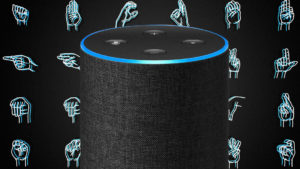 Yep. It happened. Somebody made an app for deaf people who use American Sign Language (ASL) to interact with Amazon Alexa. While all the bugs haven’t been worked out yet, the app promises a world where the deaf will no longer be excluded from technologies based on non-text input. Since most people can enjoy the benefits of voice-assisted technology, it’s a step in the right direction.
Yep. It happened. Somebody made an app for deaf people who use American Sign Language (ASL) to interact with Amazon Alexa. While all the bugs haven’t been worked out yet, the app promises a world where the deaf will no longer be excluded from technologies based on non-text input. Since most people can enjoy the benefits of voice-assisted technology, it’s a step in the right direction.
The question for people who do real-time interpretation for a living is: How soon will computers take over the industry? The answer is that such a future hasn’t arrived yet, and it isn’t likely to come tomorrow. Still, wise language service providers need to be ready to explain the advantages of human interpretation in situations where every word counts.
Where Current AI Fails in Interpretation
Interpretation of basic words and phrases is relatively easy for both beginning language learners and computers. Where it gets tricky is when the language being used has more than just a limited, literal meaning.
At its current level of sophistication, computer technology can start with a gesture in American Sign Language and replace it with its literal English equivalent. That’s great if all you want is for Alexa to turn on the TV. The technology isn’t ready for interpreting more complex meanings, though.
Cultural meanings, figurative language, and contextual cues need to be considered, too, to come up with the true and exact meaning the signer intended.
Cultural Meanings
Culture is defined as the way of life in a specific society. It can include knowledge, beliefs, and behaviors. A part of culture relates to how technologically advanced the society is. Another part is the types of art and literature in the society. All these cultural factors influence the words people in the culture use and the way they put them together.
Whether the language is ASL or a spoken language like Spanish or Chinese, it’s used differently in different cultures. A person who lives in Barcelona uses Spanish differently than someone who comes from Argentina. Culture influences the way people use sign language around the world, too.
Figurative Language
Poetry is probably the hardest type of language to translate. It’s not only filled with cultural meanings, but it also uses metaphors extensively. As an interpreter, you may never be asked to translate a poem. However, figurative language doesn’t just happen in verse. People from all walks of life use metaphors to describe their world. A human interpreter can understand that when someone uses a metaphor like “He was my rock,” they don’t mean he was a block of stone.
A computer doesn’t understand anything. It simply substitutes one word or phrase for an equivalent word or phrase. Common figurative equivalents can be programmed into the system, but what about the person who creates their own metaphors as they speak? It isn’t at all uncommon. Human interpreters know what to do with figurative language, while computers still just don’t get it.
Contextual Cues
Software developers have been working on creating software that can use contextual cues in translation. Clik earbuds translate 37 languages, and they have a contextual component, too. They can analyze the sentence before rendering an interpretation based on the contextual meaning.
Yet, context often goes beyond a single sentence. The context may be found in the entire conversation as well as in the location where the conversation is taking place and the people who are present there. An interpreter who is right there in the room with the speaker or signer has much more information about the context of the conversation than a machine currently has to work with.
Besides that, contextual cues are constantly changing, because, well, the world is constantly changing. The human interpreter can stay abreast of the newest words and phrases, and they can recognize and understand word inventions as they happen.
What Can a Language Service Provider Do?
It’s a good idea to document instances where human interpretation was essential to the correct understanding of important details. If you follow privacy protocols, you can use those examples to build your reputation. Besides that, interpreters who are fully aware of the difference they’re making will be more motivated to stay in the industry.
Getting on the Technology Bandwagon
Computers probably won’t be able to come close to the proficiency of a human interpreter for the foreseeable future. Computer interpretation might work fine for common daily tasks, but when precision and accuracy are absolutely required, such as in a court or a hospital, computers just aren’t up to the task.
At the same time, technology can be very useful for interpreters. Just having smartphones and tablets can enhance the interpreter’s workflow. Interpreter software solutions are also helpful for promoting the language service provider’s reputation. The software we provide at Interpreter Intelligence can help with scheduling and workforce management to help get the right interpreters with the right qualifications where they’re needed. That’s important. After all, if you want to do it better than a machine, you have to have the right interpreter for each job.
So far, there is no viable substitute for a human interpreter. As technology advances, language service providers will need to stay aware of the state of the industry. They’ll need to adapt to the changes that are coming. They’ll need to use technology for their own purposes, to manage their interpreters and customers, to build their reputation, and to grow their business. Most of all, they’ll need to educate their customers on the superiority of human interpretation.

Recent Comments